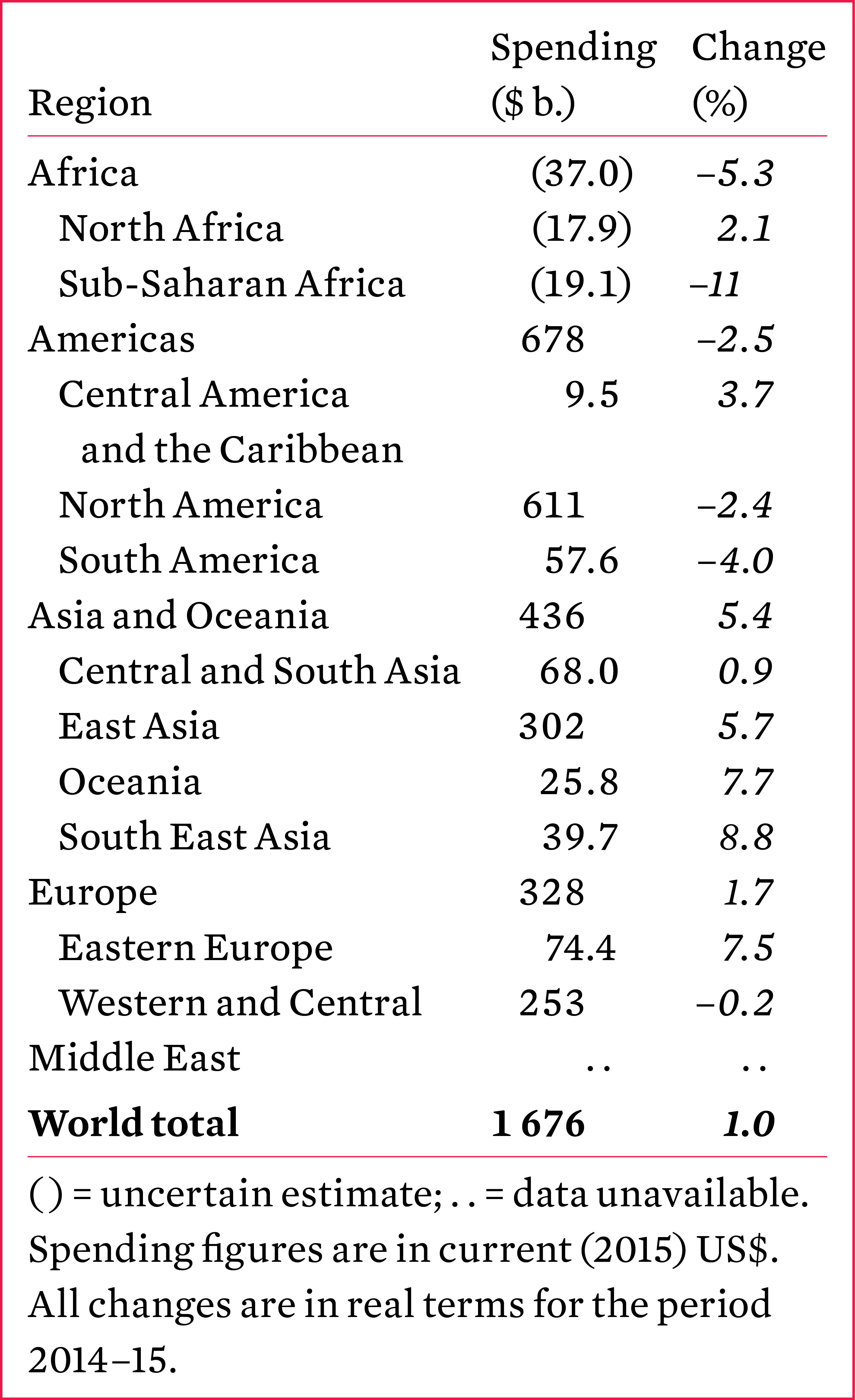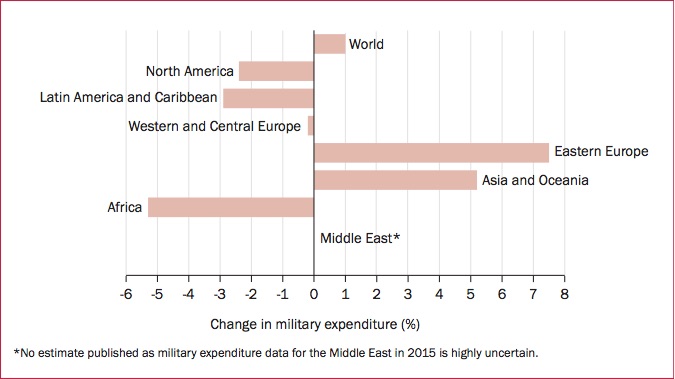13. Military expenditure
Overview, Sam Perlo-Freeman [PDF]
I. Global developments in military expenditure, Sam Perlo-Freeman, Aude Fleurant, Pieter D. Wezeman and Siemon T. Wezeman [PDF]
II. United States' military expenditure, Aude Fleurant [PDF]
III. China's military expenditure, Sam Perlo-Freeman [PDF]
IV. Military and social expenditure, Sam Perlo-Freeman [PDF]
V. The reporting of military expenditure data to the United Nations, Noel Kelly [PDF]
VI. About SIPRI military expenditure data, Sam Perlo-Freeman [PDF]
World military expenditure is estimated to have been $1676 billion in 2015, representing 2.3 per cent of global gross domestic product or $228 per person. Total global expenditure in 2015 was about 1.0 per cent higher in real terms than in 2014.
Military expenditure continued to fall in North America and Western Europe in 2015, albeit at a slower pace than in previous years. Spending also fell in Latin America and Africa, in the latter case reversing many years of increases. By contrast, military expenditure continued to rise in Asia and Oceania, Eastern Europe and those countries in the Middle East for which data is available.
Trends in military spending
The sharp fall in the price of oil, which began in late 2014, led to correspondingly sharp falls in military spending in several oil-producing countries that had been increasing such spending rapidly in recent years when oil prices were high. Although spending rises continued in some other oil-producing countries, it was often at a slower pace than in previous years and with the expectation of falling spending in 2016. Thus, the oil-fuelled boom in non-Western military expenditure appears to be coming to an end.
Military spending by the United States continued to fall in 2015, but there are signs that the decreases are coming to an end with a projected rise in 2016. Nonetheless, the USA remained by far the world’s largest military spender in 2015 with $596 billion or 36 per cent of the world total.
Chinese military spending grew again in 2015, roughly in line with economic growth. The 2015 Chinese defence white paper on military strategy presented a fairly negative view of the geopolitical security environment. It signalled an expansion of China’s military ambitions, especially in the maritime domain, and a shift in the focus of the defence strategy from land to sea. The Chinese Government made major efforts to tackle corruption in the military in 2015, including the arrest of numerous senior military officers and officials.
World military spending, 2015

Opportunity costs of military expenditure
The opportunity costs of military expenditure in terms of spending on human, social and economic development is once again a salient topic. A comparison of trends in spending on the military, health and education since 1995 shows that a majority of countries have increased health and education spending, while reducing military spending. The trend in some states in the Middle East and Eastern Europe, however, has gone in the opposite direction. An increasing majority of countries spend more on health than on military spending, but states in the Middle East, along with many oil-revenue dependent states in other regions, tend to be exceptions. There is no apparent correlation between trends in countries’ spending on the military and their spending on health.
A number of studies have considered the cost of achieving the various Sustainable Development Goals (SDGs), which were adopted by the United Nations in 2015. By comparing the sums discussed in these studies with the level of global military spending, assessments can be made about how much could be achieved if a proportion of world military spending were redirected to the SDGs. SDG 4 on education could be comfortably achieved at a cost of well under 10 per cent of annual global military spending, while eliminating extreme poverty and hunger (SDGs 1 and 2) would cost just over 10 per cent. A little less than half the world’s annual military spending would be sufficient to meet the majority of those SDGs for which additional economic resources are a central requirement.
Changes in military expenditure, by region, 2014–15
Military expenditure data
National response rates to the UN reporting instrument on military spending continue to decline. The SIPRI tables of military expenditure by country are freely accessible online via the Military Expenditure Database.
